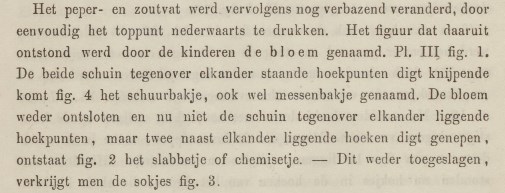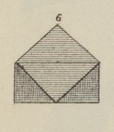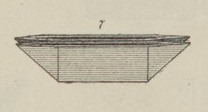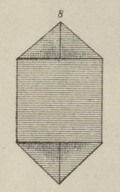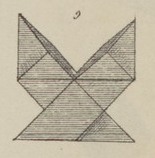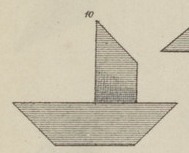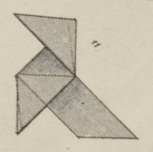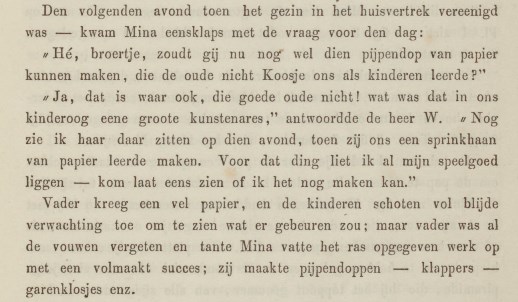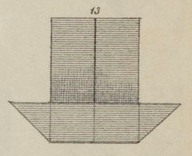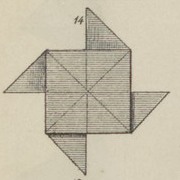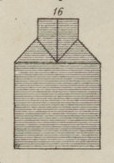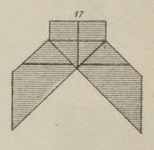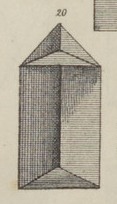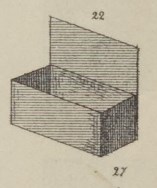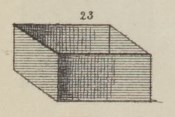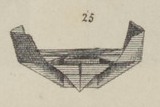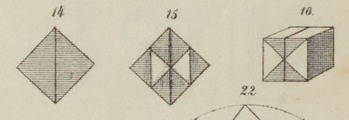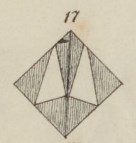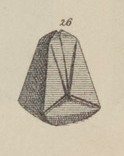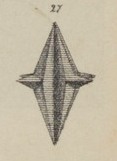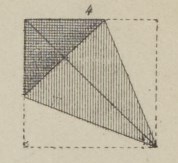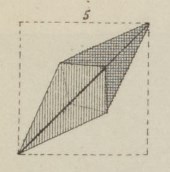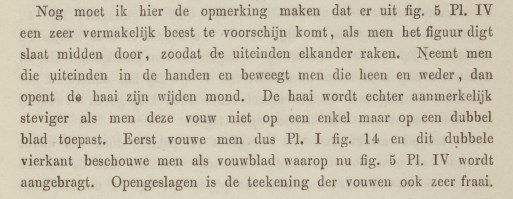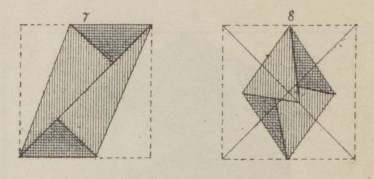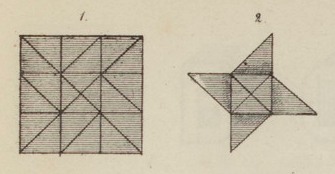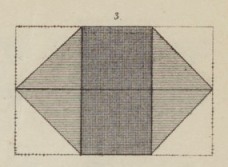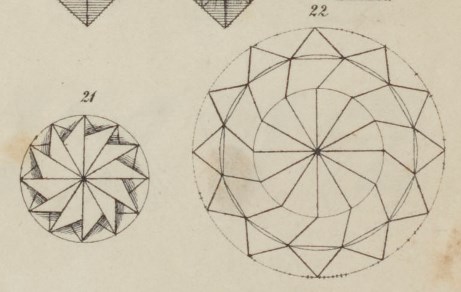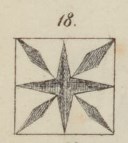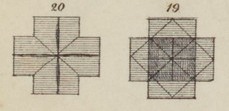| The Public Paperfolding History Project
Last updated 11/11/2025 x |
|||||||
| De Kleine Papierwerkersby Elise Van Calcar: Volume 1 - Het Vouwen, 1863 | |||||||
| 'De
Kleine Papierwerkers' was a series of four books written
by Elise Van Calcar and published by K H Schadd in
Amsterdam in 1863. The four volumes are: Volume 1: 'Wat men van een stukje papier al maken kan: Het vouwen' (What one can make from a piece of paper: Folding) Volume 2: Wat men uit strookjes papier al vlechten kan (What one can braid from strips of paper) Volume 3: Het prikken (Pricking). This volume contains no paperfolding content. Volume 4: Het Knippen en plakken (Cutting and Pasting). This page is based on the 1864 second edition of the work (a full copy of which can be accessed online here). I have not seen a copy of the first edition, however I believe that the first and second editions contain the same material. The first chapter of the book is a story wherein a youthful Aunt Mina amuses seven of her nieces and nephews by teaching them to fold things out of paper. The rest of the book is a straightforward Froebelian manual of Falten. On page 41 the author comments, roughly, 'It would be impossible to list or describe every fold that can be made from a sheet of paper. Every practitioner will dare to add to that number with his own findings ... because it is almost impossible not to continually make new discoveries in this rich variety of forms.'
**********
********** Analysis Leervormen (Learning Forms) - Folds of Life Towards the end of the book there is a 'Lijst de van Leervormen' (List of the Learning Forms) which gives the titles of 38 paper folds, divided into 5 groups, most of which which are also helpfully pictured in plates III, IV and VII. There is also a plate showing a folded alphabet. There are a number of anomalies. Some designs listed in the lists are not pictured in the illustrations. Some designs pictured in the illustrations are not listed in the lists. There are others which although both listed and illustrated are not mentioned in the text. There are also a few discrepancies in the numbering of the illustrations. The paragraph shown below describes how to change the Pepperpot into the Flower, then says, roughly, 'The two diagonally opposite corner points squeeze close to each other (to produce) the 'schuurbakje' (sandbox) also called the 'messenbakje' (knife tray).' This is a little confusing since although there are both a sandbox (no 4) and a knife tray (no 24) in the lists this seems to describe a different design. It appears to be the King's Crown opened out to be used as a container.
I have done the best I can to puzzle my way through these anomalies but have not succeeded in clearing them all up. If anyone has better insights I would love to hear them. Group 1: 1. De bloem - The Flat Flower
********** 2. Het chemisetje - The Collar Made in a similar way to the Seedpod, except that two of the points must be left inside the design and the other two folded in zigzag fashion to produce the collars. This procedure is not at all clear from the text but can be reconstructed from the picture.
********** 3. De sokjes (the sock) - The Socks (made by folding the het chemisetje in half backwards)
********** 4. Het schuurbakje (the sandbox) - The Sandbox A sandbox was a standard part of Kindergarten equipment.
********** 5. Het peper-en zoutvat (the pepper and salt shaker) - The Pepperpot
********** 6. Het reistaschje (travel pouch) - The Travel Bag Made by squashing the Pepperpot flat sideways.
********** Group 2: (These are all designs that can be developed from what we now call the windmill base.) 7. De schuitjes (boats) - The Double Boat
********** 8. De sigarenkoker (cigarcase) - The Cigar Case
********** 9. De bloemvaas (the flower vase) - The Vase
********** 10. Het zeilschip (the sailing ship) - The Boat with Sail
********** 11. De sprinkhaan (the grasshopper) - The Cocotte /Pajarita
In this dialogue, from page 9, Aunt Mina says, roughly, 'Hey brother, can you still make the pipecap that old cousin Koosje taught us as children?', to which he replies, '... I still see her sitting there that evening when she taught us to make a grasshopper (ie the Cocotte) out of paper. I left all my toys for that thing ...'.
********** 12. De inktvisch (the cuttlefish) - The Squid
********** 13. De kop en schotel (the Cup and Saucer) - The Cup and Saucer
********** 14. De molen (the mill) - The Windmill
********** 15. De tafel (the table) - The Table
********** Group 3: 16. De theebus (the tea caddy) - The Inkwell
********** 17. De visschersbroek (the fisherman's pants) - The Trousers
********** 18. Het visschersbuis (the fisherman's top) - The Jacket
********** 19. Der inktkoker (the inkwell) - The Steamship
********** 20. Het hoekkastje - The Corner Cabinet In the text this design is developed from the Cigar Case by bringing out one end and then interlocking the two sets of arms.
********** 21. De bank (the bank) - The Bench The text says that this design is developed from the Cigar Case.
********** 22. Het swavelbakje (the sulphur box) - The Sulphur Box It is not clear to me how this design is to be folded.
********** Group 4: 23. Twee schuitjes (two boats). No illustration, but from the text this is the Double Boat folded from a blintzed windmill base. ********** 24: Het messenbakje (the knife tray) - a version of The Portfolio. The nature of this design is not clear in this work. It is much more clear in 'Froebels Methode' by the same author, which see. ********** 25. Het ashbakje (the ash tray) - In the text this box is described as a 'zakje met twee taschjes' (box with two handles) and must therefore be The Junk Box.
********** 26. De spiegel (the mirror) - The Looking Glass Made by collapsing the sides of the Junk Box.
********** 27. De sloep of gondel, het wiegje (The sloop or gondola, the crib) - The Chinese Junk
********** Group 5: 28. De teerling (the die) - The Waterbomb.
********** 29. De luchtballon (the hot air balloon) - The Hot Air Balloon
********** 30. De blassbalk (blassbalg in Afrikaans means the bellows) - The Bellows
********** 31. Het peperhuis (the pepper house). Plate IV picture 4. I cannot find a mention of this design in the text and I do not understand the relevance of the name.
********** 32. De haai (the shark). Plate IV picture 5. - The Talking Fish
Part of this paragraph roughly translates as 'I must comment here that ... a very amusing beast emerges when you flex the figure through the middle so that the ends touch each other. If you take those ends in your hands and move them backwards and forwards the shark opens its wide mouth. The shark becomes considerably firmer if this fold is applied not on a single but on a double sheet.' ********** 33. Het couvert (the place setting). Plate IV pictures 7 and 8. I cannot find a reference to this design in the text, nor do I understand the relationship between these two pictures.
********** 34. Het speldentasche (the pin badge) - The Puzzle Purse.
********** 35. De klapper (the clapper) - The Double-Barrelled Banger
********** 36. De pijpendop (the pipe cap) - The Pipe Cap In the text the design is also called a 'kleine bisschopsmutje' (little bishop's hat).
In this dialogue, rom page 9, Aunt Mina says, roughly, 'Hey brother, can you still make the pipecap that old cousin Koosje taught us as children?', to which he replies, '... I still see her sitting there that evening when she taught us to make a grasshopper (ie the Cocotte) out of paper. I left all my toys for that thing ...'.
********** 37. Het garenklosje (the yarn spool) - The Yarn Spool An otherwise unknown crease and collapse design from a 2:3 rectangle divided into thirds.
********** 38. De beurs of tabakzak (the purse or tobacco bag) - The Tobacco Pouch
********** There are also two other designs pictured in plate VII which do not appear in the lists and, as far as I can see, are not mentioned in the text.: Picture 18 - The Cross Star
********** Pictures 19 and 20 - The Cross
********** In addition Plate VIII illustrates a 25 letter alphabet made from zigzag folded strips. Q is omitted.
**********
********** **********
********** Geometrical paperfolds - Erkennnisformen Plate 1 shows the sequence of folds which create the Double Blintz Basic Form.
********** Plates 2 and 4 show various geometric forms and crease patterns folded from the square using 90/45/22.5 and 60/30 degree folding geometries. Picture 1 of plate 4 shows an equilateral triangle folded from a square
********** Plates 5 and 6 show geometrical designs folded from bronze rectangles, including ways to to construct a diamond and a hexagon.
**********
**********
********** |
|||||||


